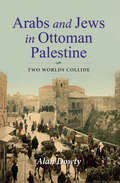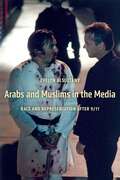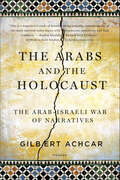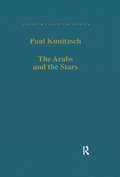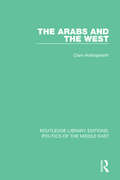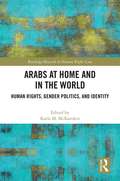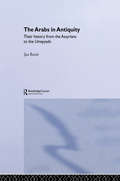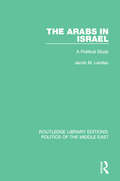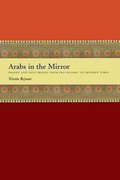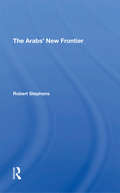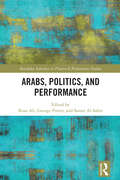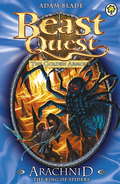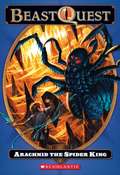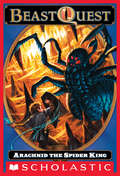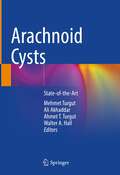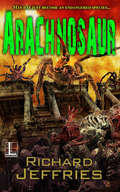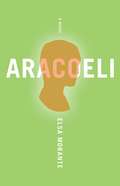- Table View
- List View
Arabs and Jews in Ottoman Palestine: Two Worlds Collide (Perspectives On Israel Studies)
by Alan DowtyThe historian and expert on Israeli-Palestinian relations offers &“a well-written, well-balanced&” account of cultural conflicts in the region before WWI (Anita Shapira, author of Israel: A History).When did the Arab-Israeli conflict begin? Some discussions focus on the 1967 war, some go back to the creation of the state of Israel in 1948, and others look to the beginning of the British Mandate in 1922. Alan Dowty, however, traces the earliest roots of the conflict to the Ottoman Empire in the 19th century, arguing that this historical approach highlights constant clashes between religious and ethnic groups in Palestine. Dowty demonstrates that, during the 19th century, there was an overwhelming hostility to European foreigners, and that Arab residents viewed new Jewish settlers as European. He also shows that Jewish settlers had tremendous incentive to minimize all obstacles to settlement, including the inconvenient hostility of the existing population. Dowty's thorough research reveals how events that occurred over 125 years ago shaped the implacable conflict that dominates the Middle East today.
Arabs and Muslims in the Media: Race and Representation after 9/11 (Critical Cultural Communication)
by Evelyn AlsultanyAfter 9/11, there was an increase in both the incidence of hate crimes and government policies that targeted Arabs and Muslims and the proliferation of sympathetic portrayals of Arabs and Muslims in the U.S. media. Arabs and Muslims in the Media examines this paradox and investigates the increase of sympathetic images of “the enemy” during the War on Terror.Evelyn Alsultany explains that a new standard in racial and cultural representations emerged out of the multicultural movement of the 1990s that involves balancing a negative representation with a positive one, what she refers to as “simplified complex representations.” This has meant that if the storyline of a TV drama or film represents an Arab or Muslim as a terrorist, then the storyline also includes a “positive” representation of an Arab, Muslim, Arab American, or Muslim American to offset the potential stereotype. Analyzing how TV dramas such as The Practice, 24, Law and Order, NYPD Blue, and Sleeper Cell, news-reporting, and non-profit advertising have represented Arabs, Muslims, Arab Americans, and Muslim Americans during the War on Terror, this book demonstrates how more diverse representations do not in themselves solve the problem of racial stereotyping and how even seemingly positive images can produce meanings that can justify exclusion and inequality.
The Arabs and the Holocaust: The Arab-Israeli War of Narratives
by Gilbert AchcarAn unprecedented and judicious examination of what the Holocaust means—and doesn't mean—in the Arab world, one of the most explosive subjects of our timeThere is no more inflammatory topic than the Arabs and the Holocaust—the phrase alone can occasion outrage. The terrain is dense with ugly claims and counterclaims: one side is charged with Holocaust denial, the other with exploiting a tragedy while denying the tragedies of others. In this pathbreaking book, political scientist Gilbert Achcar explores these conflicting narratives and considers their role in today's Middle East dispute. He analyzes the various Arab responses to Nazism, from the earliest intimations of the genocide, through the creation of Israel and the destruction of Palestine and up to our own time, critically assessing the political and historical context for these responses. Finally, he challenges distortions of the historical record, while making no concessions to anti-Semitism or Holocaust denial. Valid criticism of the other, Achcar insists, must go hand in hand with criticism of oneself.Drawing on previously unseen sources in multiple languages, Achcar offers a unique mapping of the Arab world, in the process defusing an international propaganda war that has become a major stumbling block in the path of Arab-Western understanding.
The Arabs and the Stars: Texts and Traditions on the Fixed Stars and Their Influence in Medieval Europe
by Paul KunitzschThe influence of Arabic-Islamic science on European astronomy is still evident in the number of terms and star names which derive from the Arabic. These articles examine what the Arabs - and other peoples of the Islamic world - knew about the fixed stars and the constellations, and the astrological traditions they associated with them. Professor Kunitzsch shows how the early folk astronomy of the Arabs was radically altered, without being swept away, by the discovery of ancient Greek, also Indian and Persian, sources; by far the most important of these was the Almagest of Ptolemy. This knowledge was then transmitted to medieval Europe, to Byzantium and, especially, to Spain, as the articles go on to describe, and was a vital factor in stimulating the development of scientific thought in the West.
The Arabs and the West (Routledge Library Editions: Politics of the Middle East #4)
by Clare HollingworthThis volume by acclaimed war reporter Clare Hollingworth , first published in 1952, surveys the politics of an area which has produced, and is likely to produce, more wars that it can consume locally. After a historical opening, about the general situation during and after the war, the author devotes chapters to the different States, and writes in some detail of the main problems affecting the area, such as oil, military power, communism and industrialization.
Arabs and Young Turks: Ottomanism, Arabism, and Islamism in the Ottoman Empire, 1908-1918
by Hasan KayaliArabs and Young Turks provides a detailed study of Arab politics in the late Ottoman Empire as viewed from the imperial capital in Istanbul. In an analytical narrative of the Young Turk period (1908-1918) historian Hasan Kayali discusses Arab concerns on the one hand and the policies of the Ottoman government toward the Arabs on the other. Kayali's novel use of documents from the Ottoman archives, as well as Arabic sources and Western and Central European documents, enables him to reassess conventional wisdom on this complex subject and to present an original appraisal of proto-nationalist ideologies as the longest-living Middle Eastern dynasty headed for collapse. He demonstrates the persistence and resilience of the supranational ideology of Islamism which overshadowed Arab and Turkish ethnic nationalism in this crucial transition period. Kayali's study reaches back to the nineteenth century and highlights both continuity and change in Arab-Turkish relations from the reign of Abdulhamid II to the constitutional period ushered in by the revolution of 1908.Arabs and Young Turks is essential for an understanding of contemporary issues such as Islamist politics and the continuing crises of nationalism in the Middle East.
Arabs at Home and in the World: Human Rights, Gender Politics, and Identity (Routledge Research in Human Rights Law)
by Karla M. McKandersThis volume brings together an interdisciplinary group of scholars from the United States, the Middle East, and North Africa, to discuss and critically analyze the intersection of gender and human rights laws as applied to individuals of Arab descent. It seeks to raise consciousness at the intersection of gender, identity, and human rights as it relates to Arabs at home and throughout the diaspora. The context of revolution and the destabilizing impact of armed conflicts in the region are used to critique and examine the utility of human rights law to address contemporary human rights issues through extralegal strategies. To this end, the volume seeks to inform, educate, persuade, and facilitate newer or less-heard perspectives related to gender and masculinities theories. It provides readers with new ways of understanding gender and human rights and proposes forward-looking solutions to implementing human rights norms. The goal of this book is to use the context of Arabs at home and throughout the diaspora to critique and examine the utility of human rights norms and laws to diminish human suffering with the goal of transforming the structural, social, and cultural conditions that impede access to human rights. This book will be of interest to a diverse audience of scholars, students, public policy researchers, lawyers and the educated public interested in the fields of human rights law, international studies, gender politics, migration and diaspora, and Middle East and North African politics.
The Arabs, Byzantium and Iran: Studies in Early Islamic History and Culture (Variorum Collected Studies)
by C.E. BosworthThis collection of articles by Professor Bosworth contains a series of studies on the Arab-Persian heartland of the medieval Islamic world, from the Levant to Afghanistan and the borderlands with India. The emphasis is on historical, religious, cultural and literary aspects of the region's history, from pre-Islamic times to the medieval period. A number of the studies focus on the Arab caliphate and the successor dynasties that arose from it in the Iranian world, others focus on Muslim perceptions of other faiths in the Middle East and on the relations of the ruling Muslim institution with its non-Muslim minorities. One particular group is also concerned with the prolonged contacts and interaction between Islam and the Byzantine Empire.
The Arabs in Antiquity: Their History from the Assyrians to the Umayyads
by Jan RetsoThe history of the Arabs in antiquity from their earliest appearance around 853 BC until the first century of Islam, is described in this book. It traces the mention of people called Arabs in all relevant ancient sources and suggests a new interpretation of their history. It is suggested that the ancient Arabs were more a religious community than an ethnic group, which would explain why the designation 'Arab' could be easily adopted by the early Muslim tribes. The Arabs of antiquity thus resemble the early Islamic Arabs more than is usually assumed, both being united by common bonds of religious ideology and law.
The Arabs in Israel: A Political Study (Routledge Library Editions: Politics of the Middle East #5)
by Jacob M. LandauThis book, first published in 1969, presents a comprehensive survey and analysis of the political behaviour of the Arabs in Israel, covering the period from the founding of the State to the Six-Day War in 1967. While the socio-economic background is outlined, the chief emphasis is on the political attitudes of this minority and its reactions to the modernization of political structures. The main chapters deal with adaptation versus alienation; cultural change and its reflection in politics; political organizations; voting behaviour in parliamentary, local, and trade union elections; leadership and the foci of political activity. Materials used for research included the Israeli press, both in Arabic and Hebrew, the literature produced by the Arabs in Israel, official publications and private reports, as well as interviews conducted with Arabs from all over the country.
Arabs in the Mirror
by Nissim RejwanWhat is an Arab? Though many in the West would answer that question with simplistic stereotypes, the reality is far more complex and interesting. Arabs themselves have been debating Arab identity since pre-Islamic times, coming to a variety of conclusions about the nature and extent of their "Arabness. " Likewise, Westerners and others have attempted to analyze Arab identity, reaching mostly negative conclusions about Arab culture and capacity for self-government. To bring new perspectives to the question of Arab identity, Iraqi-born scholar Nissim Rejwan has assembled this fascinating collection of writings by Arab and Western intellectuals, who try to define what it means to be Arab. He begins with pre-Islamic times and continues to the last decades of the twentieth century, quoting thinkers ranging from Ibn Khaldun to modern writers such as al-Ansari, Haykal, Ahmad Amin, al-'Azm, and Said. Through their works, Rejwan shows how Arabs have grappled with such significant issues as the influence of Islam, the rise of nationalism, the quest for democracy, women's status, the younger generation, Egypt's place in the Arab world, Israel's role in Middle Eastern conflict, and the West's "cultural invasion. " By letting Arabs speak for themselves, Arabs in the Mirror refutes a prominent Western stereotype--that Arabs are incapable of self-reflection or self-government. On the contrary, it reveals a rich tradition of self-criticism and self-knowledge in the Arab world.
The Arabs' New Frontier
by Robert StephensThis book explores the Arab world and its development problems as its new oil wealth opens up prospects of accelerated economic and social progress. It describes Kuwait's aid operations and looks at the effect the sudden torrent of oil money has had on the Kuwaitis.
The Arabs of the Ottoman Empire, 1516-1918
by Bruce MastersThe Ottomans ruled much of the Arab World for four centuries. Bruce Masters's work surveys this period, emphasizing the cultural and social changes that occurred against the backdrop of the political realities that Arabs experienced as subjects of the Ottoman sultans. The persistence of Ottoman rule over a vast area for several centuries required that some Arabs collaborate in the imperial enterprise. Masters highlights the role of two social classes that made the empire successful: the Sunni Muslim religious scholars, the ulama, and the urban notables, the acyan. Both groups identified with the Ottoman sultanate and were its firmest backers, although for different reasons. The ulama legitimated the Ottoman state as a righteous Muslim sultanate, while the acyan emerged as the dominant political and economic class in most Arab cities due to their connections to the regime. Together, the two helped to maintain the empire.
Arabs, Politics, and Performance (ISSN)
by Samer Al-Saber Roaa Ali George PotterThis book is a ground-breaking collection on contemporary Arab theatre.Through three sections discussing occupation and resistance, diaspora, migration, and refugees, and nationalism and belonging, this study provides nuanced responses to the contested points of intersection between Arab culture and the West, as well as many of the major concerns within contemporary Arab theatre. The collection draws together scholars from the Middle East, North Africa, Europe, and the United States who write about Arab theatre and the representation of Arabs on European and American stages. It introduces concerns in contemporary Arab theatre, the regions in which Arab theatre is performed, and the issues with representations of Arabs onstage.This volume will be of great significance for those interested in expanding the range of global, postcolonial, African, Asian, or diasporic theatre that they study, teach, or stage.
Arachne Spins Her Web
by Jesse TiseWhy do spiders spin their webs? According to the ancient Greeks, it can be traced back to the myth of an arrogant young woman who angered the gods.
Arachne the Weaver
by Rebecca Grudzina Niki Leonidou Lori O'DeaThe goddess Athena challenges Arachne to a weaving contest and ends up a sore loser.
Arachne the Weaver
by Rebecca Grudzina Lori O'Dea Niki LeonidouThe goddess Athena challenges Arachne to a weaving contest and ends up a sore loser.
The Arachnean and Other Texts (Univocal)
by Fernand DelignyThe Arachnean and Other Texts by Fernand Deligny (1913–1996) is a collection of writings from the second half of the 1970s. In 1968 Deligny established a &“network&” for informally taking care of children with autism that was more than a mere site of living: it was a milieu created out of a reflection on the mode of being autistic. What is a space perceived outside of language? What is the form of a movement without perspective or goal? How do we engage with a world that is not our own, a world turned upside down yet truly common, where acting cohabitates with our actions and the unknown with our forms of knowledge? Such is the mythical web of the &“Arachnean,&” made of lines, holes, traces, enigmas, and questions without answers that demand to see that which cannot be seen. Long before the digital age of social networks, meshworks, and digital webs, Fernand Deligny speaks to us in his own autobiographical and aphoristic manner. For Deligny, his life was always experienced in the form of &“the network as a mode of being.&”
Arachnid the King of Spiders: Series 2 Book 5 (Beast Quest #11)
by Adam BladeBattle fearsome beasts and fight evil with Tom and Elenna in the bestselling adventure series for boys and girls aged 7 and up. The Evil Wizard Malvel has stolen the magical suit of golden armour and scattered it throughout Avantia. Tom vows to find the pieces - but they are guarded by six terrifying new Beasts! In the caves of Avantia lurks Arachnid the King of Spiders. Massive and terrifying, Arachnid preys on the local townspeople and guards a piece of the magical golden armour. Can Tom defeat the Beast and save the kingdom from destruction?There are SIX thrilling adventures to collect in the Beast Quest: The Golden Armour series: Zepha the Monster Squid; Claw the Giant Monkey; Soltra the Stone Charmer; Vipero the Snake Man; Arachnid the King of Spiders; Trillion the Three-Headed Lion.If you like Beast Quest, check out Adam Blade's other series: Team Hero, Sea Quest and Beast Quest: New Blood!
Arachnid the Spider King (Beast Quest, Book #11)
by Adam BladeIn the caves of Avantia lurks Arachnid, the King of Spiders. Massive and terrifying, Arachnid preys on the local townspeople and guards a piece of the magical golden armor. Can Tom defeat the Beast and save the kingdom from destruction?
Arachnid the Spider King: Arachnid the Spider King (Beast Quest #11)
by Adam BladeOne boy's journey to save his village becomes a quest to save the Kingdom.In the caves of Avantia lurks Arachnid the Spider King. Massive and terrifying, Arachnid preys on the local townspeople and guards a piece of the magical golden armor. Can Tom defeat the Beast and save the kingdom from destruction?
Arachnoid Cysts: State-of-the-Art
by Mehmet Turgut Ali Akhaddar Ahmet T. Turgut Walter A. HallThis book provides an in-depth review of the knowledge of craniospinal arachnoid cysts, with emphasis on epidemiology, genetics, neuroimaging, clinical presentations, and operative management. Sections on postoperative complications, outcome, and medicolegal aspects of this entity are also included. This richly illustrated book will help the reader in choosing the most appropriate way to manage this challenging neurosurgical disease process. This work also considers future areas of investigation and innovative therapeutic philosophies. This comprehensive reference book will be an ideal source for neuroscientists at all levels of their training in multiple different disciplines, from graduate students to specific research scientists studying this topic, including neurosurgeons, neurologists, neuroradiologists, pediatricians, and those seeking both basic and more sophisticated information regarding craniospinal arachnoid cysts.
Arachnophobia
by Nicholas EdwardsBased on the Motion Picture, Arachnophobia, from Hollywood Pictures and Amblin Entertainment, Inc.
Arachnosaur
by Richard JeffriesDESERT SWARM After his superior officers are killed in action, Corporal Josiah Key assumes command of the 3rd Battalion, Marine Raiders. In the tiny village of Shabhut, Yemen, while trying to put the blast on ISIS forces, an even deadlier enemy emerges: ancient, unreasoning creatures who tear into both U.S. troops and terrorists without mercy, leaving brutally dismembered corpses in their wake. They are known as the Idmonarchne Brasieri, giant prehistoric spiders roused from millennia-long slumber by power-mad terrorists. These aptly-named ‘Arachnosaurs’ are hungry. They’re angry. And they have declared war against all of humanity . . . whose days might just be numbered unless Key and his unit can stop them. ARACHNOSAUR
Aracoeli
by Elsa Morante William Weaver<P>Aracoeli―Elsa Morante's final novel―is the story of an aging man's attempt to recover the past and get his life on track in the process. The Aracoeli of the title is the narrator's deceased mother, who grew up in a small Spanish town before marrying an upper-class Italian navy ensign. The idyllic years she spends with her only son―Manuel, the narrator of the novel―are shattered when she contracts an incurable disease (probably syphilis) and becomes a nymphomaniac. <P>Now, at the age of 43, Manuel, an unattractive, self-loathing, recovering drug addict who works a dead-end job at a small publishing house, decides to travel to her hometown in Spain in order to look for her. Filled with dreams and remembrances the novel creates a Sebaldian landscape of memory out of this painful journey, painting a portrait that is both touching and bleak. <P>Appearing here for the first time in paperback―the hardcover was published in 1984―Aracoeli is an important, and long-neglected, work in Morante's oeuvre.
